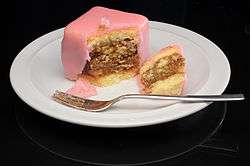Punschkrapfen
 | |
| Alternative names | Punschkrapferl |
|---|---|
| Type | Pastry |
| Place of origin | Austria |
| Main ingredients | Cake crumbs, nougat chocolate, apricot jam, rum |
|
| |
Punschkrapfen or Punschkrapferl (punch cake) is a classic Austrian confection of pastry with a fine rum flavor. It is similar to the French pastry, the petit four.
Today, one can find Punschkrapfen in most pastry shops and bakeries in Austria.
Composition
It is a cake filled with cake crumbs, nougat chocolate, apricot jam and then soaked with rum. The cake is cut into 1-1/2 inch square cubes,[1][2] covered with so called Punschglasur (punch icing), a thick pink rum sugar glazing often drizzled with chocolate and a cocktail cherry on top. Nowadays, there are also Punschkrapfen in cylindrical form.
History
It is disputed who made the first Punschkrapfen and where it came from. It may have been introduced to Vienna in the Middle Ages by the Avars, or the Ottoman armies brought the Punschkrapfen to Vienna (the Second Turkish Siege), or it may have been invented by an imperial court confectioner.[3]
Trivia
It is said that the Punschkrapferl renders the typical Austrian character: red outside, brown inside, and always a little smashed.[4] "Punschkrapferl" is a term often used by Austrians to describe Nazi politicians who joined the Social Democrats after World War II. These politicians are said to be pink (a color associated with socialism) on the outside and brown (a color associated with Nazism) on the inside.[5]
Robert Menasse suggested satirically that the Punschkrapfen should become the Austrian National Symbol.[6]
See also
References
- ↑ with the ideal dimension being 4×4×4 cm (www.wieninternational.at)
- ↑ The Original (www.wienerpunschkrapfen.com)
- ↑ A delicious bright pink cube (www.wieninternational.at)
- ↑ Ein Punschkrapfen zu viel (www.standard.at)
- ↑ Austria's Reds Check for Brown Spots (www.dw.de)
- ↑ Menasse, Robert: Das Land ohne Eigenschaften. Essay zur österreichischen Identität. Suhrkamp. Frankfurt/M. 1995, p. 37
